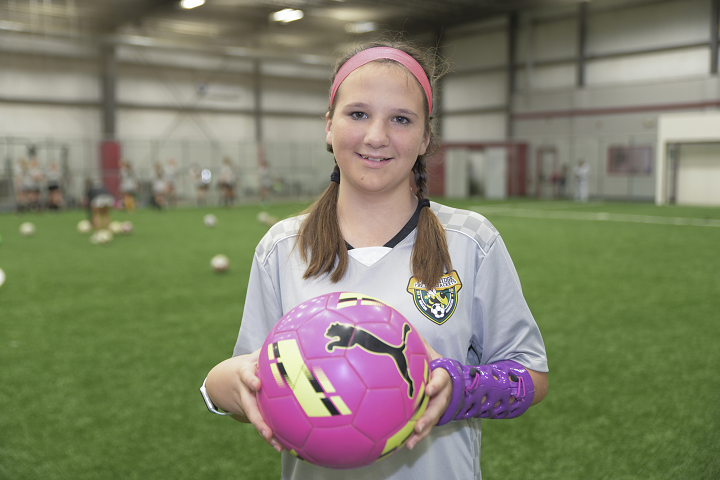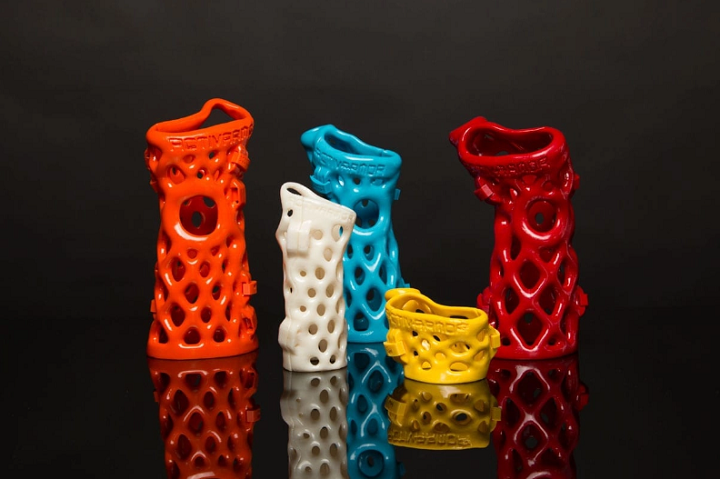First Hospital in the U.S. 3D Prints ActivArmor Casts On-site
Back in 2017, Colorado company ActivArmor went nationwide with its customizable, removable, waterproof 3D printed casts, noted once as a “killer application” for additive manufacturing. The use of ActivArmor casts has been growing ever since, and St. Luke’s University Health Network (SLHN) in Pennsylvania is now the first in the country to use its in-house 3D printing lab to fabricate these casts.
Based on scans taken on a smartphone, the casts are 3D printed on FDM desktop printers, finished by hand, vapor smoothed, and shipped off to customers. St. Luke’s orthopedic department has already been using the 3D printed casts for over a year, but actually making them onsite gets them to the patients even faster.
 Kylee Menszak with a 3D printed ActivArmor cast in 2021. Image courtesy of SLHN.
Kylee Menszak with a 3D printed ActivArmor cast in 2021. Image courtesy of SLHN.Traditional plaster casts patients are often heavy and uncomfortable, and even the more modern fiberglass option can be itchy and hard to keep clean and dry. But that doesn’t seem to be the case with ActivArmor’s casts, which are much more flexible during the healing process.
“We found that the younger population, especially, gravitate to them,” said Jessica Kamensky, the service line administrator for Musculoskeletal Services at St. Luke’s. “The device can start fastened and then transition to something that is more like a brace that can be easily removed. Kids can play with it on, bathe with it on…..it’s just so much more practical than a traditional cast.”
Diana Hall, the Founder and CEO of ActivArmor, says the company is “excited to work with some of the top innovators in orthopedics at St. Luke’s to bring this next-generation technology to market.”
“St. Luke’s reputation for quality, service and patient satisfaction align perfectly with our mission at ActivArmor: to improve the safety and quality of life for those requiring immobilization while healing,” she continued.
The idea for ActivArmor’s casts came about when Hall started a mentoring program for impoverished children in Colorado, and saw how difficult it was for them to keep up their personal hygiene when wearing plaster casts, which she called “archaic.” A former chemical engineer, Hall also worked in software engineering for Fortune 500 companies, and used her technical expertise to create a better option. After she shared her 3D printed prototypes with medical professionals, things took off quickly, and she was soon working with the FDA on the regulatory requirements, and in 2014, Hall partnered with experts at the University of Maryland to develop test protocols and complete two years of clinical field tests. The rest, as they say, is history.
“With a more comfortable cast, we’re finding patients are using it more frequently, reducing the need for pain medications and allowing for advanced healing technologies, such as muscle stimulation,” Hall said. “It’s improving healing outcomes for patients quickly and affordably, and giving people their lifestyle freedoms back.”
 Image courtesy of ActivArmor
Image courtesy of ActivArmorSt. Luke’s makes ActivArmor casts for upper extremity injuries at its in-house 3D Print and Innovation Lab, within St. Luke’s Simulation Center. Megan Augustine, MS, Network Director of the Center, led the charge in working with Hall to bring the technology to the network, and calls this in-house 3D printing ability a “game-changer” for patients.
“We initially launched a small-scale roll out that allowed us to scan the patient for the cast, upload the file and have it printed by ActivArmor in Colorado and then have it sent to us, which was typically a four-day turnaround. I asked Diana to let us know when she was ready to have the 3D printing done onsite, because we wanted to be the first in providing this type of quality care with a quicker turnaround to our patients. And now, we are currently delivering the cast in two business days. We expect to cut that down to same day delivery in the very near future, which is exactly want our patients want,” Augustine said.
Dustin Greenhill, MD, pediatric orthopedic surgeon at St. Luke’s Orthopedic Care, also helped in deploying the onsite 3D printing of the ActivArmor casts. He’s a big fan of the technology.
“For an active child and their parents, weeks in a cast can feel like months. I want them out of a traditional cast as soon as possible, but also need to protect the arm when kids go back to being kids. This cast lets me do both,” Greenhill explained.
“We can now get these 3D casts on kids fast – both for stable fractures that simply need to heal and, more recently, unstable injuries. For preadolescents and adolescents with a severe wrist or forearm fracture, I’m now doing their 3D scan during surgery.”
With this new capability, the St. Luke’s 3D Print and Innovation Lab can quickly print the two halves of a cast in-house, easily fitting them onto the patient’s affected body part on the same day.
“Instead of having to wait a week for a custom cast to be made and shipped, we can literally have it in hours. We are starting to scan certain (surgical) patients for it in the operating room, prior to surgery, and have it ready for them when they need it,” explained Kylie Honnick-Payne, a physician assistant who works with Dr. Greenhill. “It is just so much more convenient for the patients and their parents.”
The casts are typically covered by insurance, including Medicare and Medicaid, and the 3D printed lattice structure makes it easier to care for the wound, clean the skin, and sanitize the device itself, since it can be easily removed and also get wet. The plastic used to print the casts is said to be biocompatible and recyclable, and kids love the fun color options as well. Honnick-Payne says ActivArmor casts are so popular, some parents and patients even bring it up themselves.
“Some of them heard about it from other kids, and they’re asking us for one before we even decide it’s an option. The kids just love it.”
 Olivia Balas has her new custom-made ActivArmor cast put on by orthopedic physician assistant Kylie Honnick-Payne.
Olivia Balas has her new custom-made ActivArmor cast put on by orthopedic physician assistant Kylie Honnick-Payne.To learn more about 3D printing in the medical field, register here for the Additive Manufacturing Strategies business summit in New York City, February 7-9, 2023, hosted by 3DPrint.com and SmarTech Analysis.
Subscribe to Our Email Newsletter
Stay up-to-date on all the latest news from the 3D printing industry and receive information and offers from third party vendors.
Print Services
You May Also Like
RAPID 2025: Stratasys & trinckle Announce Strategic Software Partnership
News continues to flood in from last week’s RAPID+TCT 2025, including a new partnership between AM market leader Stratasys and Berlin-based software company trinckle. By automating important steps in fixture...
RAPID TCT 2025: Spring in the Paris of the Midwest
I’m going to go out on a limb here and say that whomever coined the phrase Detroit: Paris of the Midwest, had not spent a lot of time in Paris...
3D Printing Financials: 3D Systems Looks to Bounce Back in 2025
After a challenging year for the industry, 3D Systems (NYSE: DDD) ended 2024 with results pointing to a reset, laying the groundwork for future profitability. The company didn’t post strong...
Printing Money Episode 27: Q4 2024 Public 3D Printing Earnings Review with Troy Jensen, Cantor Fitzgerald
Q2 2025 has already begun, but public markets reporting has only just finished with Q4 2024. To tie a bow on Q4 2024, we are thankful to have Troy Jensen...

























